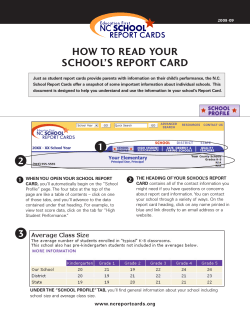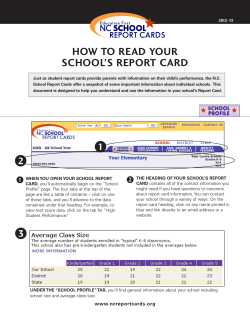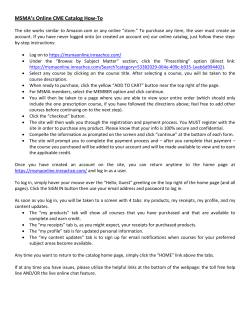
X-evm Users Manual v1.0 EVM Research LLC
X-evm Users Manual v1.0 EVM Research LLC System Requirements for X-evm Operating System MS Office Compatibility Processor CPU Architecture RAM Hard disk space Required All Windows Platforms Office 2007, 2010 and 2013 Pentium Dual Core or Above (Recommended i3) 32 and 64 bit 1 GB or Above (Recommended 2GB) Less than 1 MB Installation Instructions 1. 2. 3. 4. 5. 6. 7. 8. Save the X-evm file to your hard drive. Do not open the file yet. Open Microsoft Excel Enable Macros and Disable Protected view : a) Click the Microsoft Office /File Menu, and then click Options b) Click Trust Center > Trust Center Settings,> Macro Settings c) Select the option ‘Enable all macros (not recommended, potentially dangerous code can run)’ and also check the ‘Trust access to the VBA project object model’ box. d) Next, click on ‘Protected View’ e) Uncheck ‘Enable Protected View for files originating from the Internet ‘ f) Uncheck ‘Enable Protected View for Outlook attachments’ and click ‘OK’. Now, open the X-evm file in Excel . The ‘X-evm licensing form’ will be opened Follow the instructions to activate the software. Make sure you have internet connection during the activation process. When you have successfully actiavted X-evm, you will be prompted to choose a location to save the ‘X-evm Template’ file. Remember this location as this is your souce template for X-evm. The file will then be closed automatically. Open the File you just saved and start using X-evm. When you save your work, you will be prompted to save it under a new file name. Limitations o X-evm is not supported on Mac, Linux, Online Office or any cloud systems. o Avoid Excel® drag-down function to populate rows or copy/paste rows. Use the X-evm built in functions instead. Legal o X-evm is a teaching aid and illustrator for educational purposes only and EVM Research LLC is not responsible for financial/accounting anomalies, losses or any other irregularities resulting in your projects. Refer to the X-evm End Users Agreement. o This software is restricted to one license per machine. X-‐evm Users Manual v1.0 evmresearch.com 1 I. Overview X-evm was built simple, devoid of the complexities that come with expensive leading tools. The intent was to allow you, the project practitioner, to setup projects requiring EVM on the fly. Let’s say you are visiting a client site to assess one of their troubled projects struggling with cost overruns. You could then use X-evm to plug in some basic cost and % complete inputs, to quickly spit out the CPI and SPI. You could also use X-evm as a simulator to accelerate your own learning or simply use it to try out various what-if scenarios for your ongoing projects. Whatever the purpose might be, with X-evm, you will gain valuable insight into the powerful word of EVM. You can now build the confidence you have always wanted to manage EVM projects. II. Dashboard Fig. 1 EVM Chart The above chart illustrates PV, AC and EV plotted as a function of time available in the Dashboard tab. Figure 2 EVM Metrics X-‐evm Users Manual v1.0 evmresearch.com 2 The above table illustrates the EVM metrics snapshot available in the Dashboard tab. The DASHBOARD tab provides you a snapshot of where your project is as of today (you can choose any other status date you wish as well). The top header section consists of free form text fields for you to populate. The following are writable fields; Company Name Project Name Project Code Project Manager Placeholder 1 Placeholder 2 The following fields in the header section are automatically populated from the GANTT ENGINE. You cannot write to these fields; Project start date Project end date Project duration Starting day of week The following fields are controllers allowing you to set parameters; EV status date: Choose a status date for reviewing EVM parameters. These values are derived from the EV tab bottom most section. See Fig. 7. Show chart from week: The date you want the graph to start on, irrespective of the project start date (zoom in/out). To: How many weeks you want the graph to plot from the start date. EVM Parameters: This table displays a snapshot of EVM parameters for the date you chose in the EV status date X-‐evm Users Manual v1.0 evmresearch.com 3 Graph: Displays PV, AC and EV for the parameters you set in ‘Show chart from’ field and ‘To’ field. Use these controllers to zoom into your graphs. III. GANTT Engine The GANTT Engine is a powerful utility that helps you to build your schedule. Users must avoid performing traditional Excel ® functions as such drag, drop or copy/paste functions. The figure below shows the first half of the Gantt Engine tab. Fig. 3 Gantt Chart The following buttons are controllers; Add new rows: Adds the amount of rows you specify starting at the last row. Insert row: Use it to insert a row anyplace between the rows you already have scheduled. Note, you cannot use this to add a new row to the end of the existing rows. Delete row: Delete any row that you specify. Bulk delete: Delete the number of rows you specify from the end of the rows you already have built. Refresh; Use it to refresh the data. In case you delete the date you use this button to retrieve it. You could also try using this to clear any unintended user input errors. Weekend work: Check this box if weekend work is required. This will now include weekend days (Sat, Sun, or both weekend days) to the schedule. Resource names: Choose the resource name you have listed in the Resource tab. Multiple resources can be specified for each task and the resource column will display the number of resources for a particular task with the number of resources prefixed to the resources. The following fields are automatically generated and cannot be written to: No X-‐evm Users Manual v1.0 evmresearch.com 4 WBS % Comp: This value is derived from the EV tab. End date This value is driven by the ‘start date’ and ‘Pred’ (Predecessor). Budgeted cost This value is the budgeted cost for each task (Duration times the number of resources times Hours each resource works per day) The following fields are writable: Task name: Type the task names here. “Add rows” when you need to add more tasks. Always write one task at a time and avoid using the drag down functions to populate the rows. Predecessor: This field automatically calculates the start and end date of the task based on its predecessor. Be careful not to input invalid predecessors- you will be prompted with errors. Only finish-Start is supported. StartStart and other lead/lag functions are not supported. Fig. 4 Gantt Chart The Gantt chart view is also available in the Gantt engine tab by scrolling to the right. A 6-month view is available. To view later durations use the “select the starting week’ button to move the Gantt chart to the right. The Gantt chart is illustrated in beige and bronze graphs, with the bronze indicating the % completed. IV. Planned Value (PV) The project baseline that you build using the Gantt engine, gets translated into costs and are accumulated in this sheet. The cumulative cost/week is plotted in the graph in the DASHBOARD tab as PV. This is the line against which you X-‐evm Users Manual v1.0 evmresearch.com 5 measure progress of AC and EV. Note that you cannot write on this tab. These numbers are automatically generated and distributed across the duration of the project. Budgeted cost/week: Displays all the tasks that you listed in the GANTT tab and their respective costs for each week. You can see what the planned cost is for each task for each week. Total budgeted cost/week: This is the summation of the costs of all tasks in each week. Cumulative planned value This is the cumulative total of each week’s cost summed up in incremental order, week over week. This is the line that is plotted in the graph that you use to measure AC and EV against. The Start and End dates are also displayed for each task along with its total budgeted cost. X-‐evm Users Manual v1.0 evmresearch.com 6 V. Actual Cost (AC) Actual Cost tab where you manually enter the actual cost (AC) that each task incurs every week. It is good practice to enter these costs every week. The Actual Cost/ Week - All Tasks section is writable. Enter the weekly cost for each task here; The Actual cost/week and Cumulative costs are auto generated and cannot be written to. The cumulative cost is what makes up the AC component of the graph in the Dashboard tab. The following parameters are also auto generated and non-writable; Budg. Cost: These are the PV values for each task Total Actual Cost; How much cost you have incurred for each task to date Variance: Difference between PV and the cost you have incurred to date for each task As you can see, the above fields grant you the ability to instantaneously ascertain how much you are spending and how much you have left for each task- a great cost control feature. Fig. 5 Actual Cost tab Note the gray cells for each task. They are auto shaded during the build of PV, to guide you to the weeks’ expected cost. Now you call determine if any resource is expected to bill that week. If you don’t find any resource billings for that week, then it can indicate a missed billing or missed task. On the contrary, if someone bills during a week with no grey cells, then that could indicate a gap as well. This is a great cost control feature. VI. Earned Value (EV) Earned value is a function of PV. If you multiply the % complete of a task with the budgeted cost of that task, you will arrive at the EV for that task. This tab follows the same convention as that of the AC. You manually enter the % complete of each task in the EV/week- all tasks section. These percentages are then converted into costs (% complete times the planned value of that task). The X-‐evm Users Manual v1.0 evmresearch.com 7 EV/week row displays the total cost of tasks for each week. The cumulative EV represents the summation of the EV/week, accumulated every week. This makes up the EV component of the graph. EV/Week- all tasks: this is where you manually enter the % complete for each task for each week. EV/Week: This is auto generated and shows the total EV for each week (remember % x PV) Cumulative EV: This is the summation of the EV/week costs, week over week. Fig. 6 Earned Value Tab Note the gray cells for each task. They are auto shaded during the build of PV, to guide you to the weeks’ % completion expected. Now you call tell if any resource is expected complete a task during the gray shaded duration. In this illustration, Task 1 is scheduled for week1 – week 3. Here the resource completed 30% of the work during week 1 and made no progress during week 2, so it remains at 30%. However during the 3rd week the resource has managed to complete the entire task at 100%. On the contrary, should the work continue past the gray cells, it may indicate a delay in the completion of the task. This is a great utility to keep track of work on a weekly basis. Caution must be exercised to not enter percentage completion that is greater than 100%. This would trigger the cells to change color to red. If this happens then make the necessary changes to bring it back to less or equal to 100%. Finally, if circumstances require you to revise the % completion to a lower value than what is shown, then the costs corresponding to the revised % completion will also be decremented from the overall costs. For example, say you have a task marked at 75% at week-1, and say you want to revise it to 50% at week-2. Then, after you make the revision in week-2, 25% of the costs will be decremented from the overall cost. Ideally this type of revisions should be avoided. Instead, it’s best to simply go back in time and make the necessary revisions to week-1 and bring it to where it actually must be. This will ensure the % completion and the associated costs are gradually incremented over time. Fig.7 Graph data for PV, EV, AC This is where the cumulative totals of EV, AC and PV are stored and retrieved by the graph on the DASHBOARD tab. These 3 lines of data available at the bottom of the sheet in the EV tab. The ‘evm snapshot’ table in the DASHBOARD tab displays the data highlighted in red and generates other parameters based on these 3 data point. The cells highlighted in red are driven by the ‘ev date’ field above the ‘evm snapshot’ table. You may select any date from the ‘ev date’ box to view the EVM parameters during various durations of the project. Utilize this as a simulator to aid your learning. X-‐evm Users Manual v1.0 evmresearch.com 8 VII. Resource Rates and Cost You can list your resources on this tab, along with their rates. These rates are used to calculate the PV for each task. There are also placeholders for other information you can input for each of the resources. The below files are writable. The resource name column is the place where you enter the resources The hourly rate column holds the hourly rates for the resources The working hours/day column specifies how many hours that resource works/day. For example, 4hrs/day indicates 50% and 2hrs/day indicates 25%. This provides great flexibility for loose resources that may not be dedicated on a particular project. The details column is a placeholder to write any comments for each resource. The total budget resource cost shows the total cumulative cost for each resource. This is auto-generated and can’t be written to. This is an extremely useful table to keep track of total resource cost VIII. Holiday List You can list observed and non-observed holidays here. These are global settings that apply to all resources. The PV automatically factors these non-working days into the schedule and cost. The above fields are writable; Date: Format must be [numerical day- month – numerical year]. Example 3-Jan-2014 Description: The holiday No; this is not writable and has a limit of 60 X-‐evm Users Manual v1.0 evmresearch.com 9
© Copyright 2025














